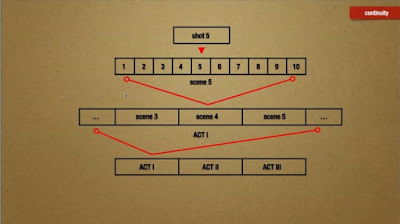Offline Editing | Continuity in Editing
Shooting for Editing
All the shots made during
the shooting process can be considered as visual material. Shooting for editing
means that the DP must get sufficient visual material coverage for the editing
process with consistent and continuous visuals between shots.
“Continuity is a
logical consistency of the story, dialog, and picture so that it presents the
appearance of reality.”[1]
 |
| 1.1 Visualization of how continuity works source: author's personal documentation |
Continuity Editing Concept
Continuity Editing is
an editing principle or style that aims to create narrative continuity and keep
it consistent throughout the film. The story logic, dialogue, and visual are
set to represent the appearance of reality. Therefore, the visual material must
contain visuals that are consistent and continuous. In this case, the DP,
director, and editor must work together to ensure that continuity is achieved.
Basic Principles of Continuity Editing[2]
- Screen Direction: direction of an object’s movement on screen.
- 180 Degree Rule: half circle established on one side of the shooting set once the camera first records and dictate from where on the film set the camera may be placed to not cause a reversal in the established screen direction.
- 30 Degree Rule: the camera should be moved around the 180 degree arc at least 30 degrees from one shot to the next to create enough variation on the angle-on-action.
- Matching Shot: same shot type and angle on a coverage shot (eg. 45 degrees, MCU)
- Eyeline Match: imaginary line which connects the character’s eye and the object or subject it sees, whether on-screen or off-screen. This can also be achieved by using a ducted c-stand.
Axis of Action: a 180 degrees area in the form of a semicircle which is the basis for all camera points placement and actor movement, ensuring the actor's point of view is always consistent and building spatial dimensions in a scene.
 |
3.1 Matching shot source: wikipedia |
Common Editing Structure / Pattern
- Establishing (LS/MLS/XLS)
- Breakdown (MS/MCU/CU/BCU/XCU)
- Re-establishing (LS/MLS/XLS)
“The 180 system prides itself on delineating space
clearly. The viewer should always know where the character in relation to
another and to the setting. More important, the viewer always knows where he or
she is with respect to the story action.”[3]
Crossing Axis of Action/Breaking the Rule:
The axis of action can be ignored if the following elements are given attention to.
- Neutral/establish shot: by setting another neutral shot to establish the new perspective before crossing the axis of action.
- Camera movement: by moving the camera from the starting position to the opposite position so that the audience can grasp the subject’s position during the change.
 |
4.1 Axis of Action source: author's personal documentation |
[1] Brown, Blain. Cinematography:
Theory and Practice 3rd Edition, page 78.
[2] Editorial Thinking on
Cinematography
[3] Bordwell, David, et al. Film
Art: An Introduction 11th Edition, page 233.







Comments
Post a Comment